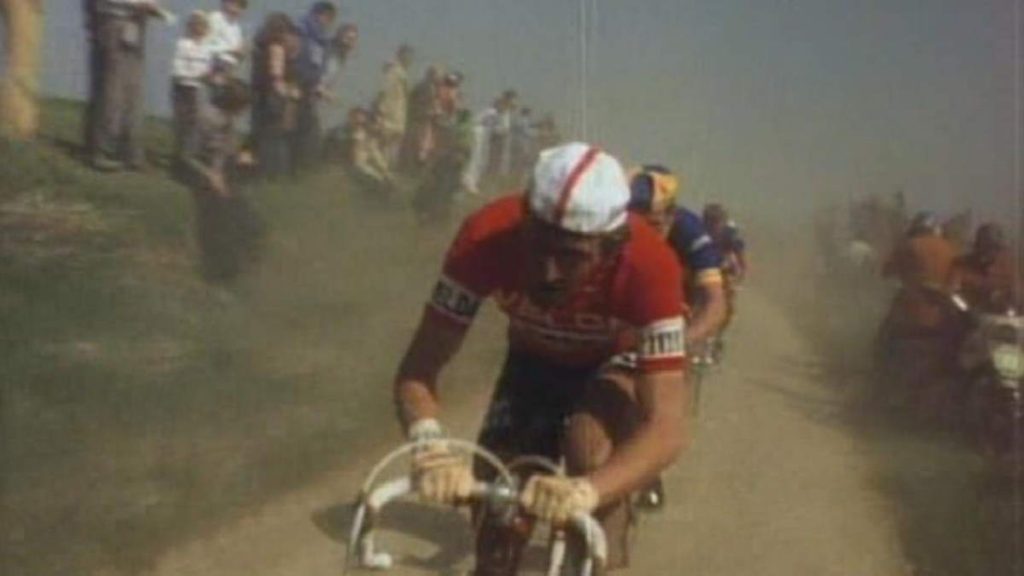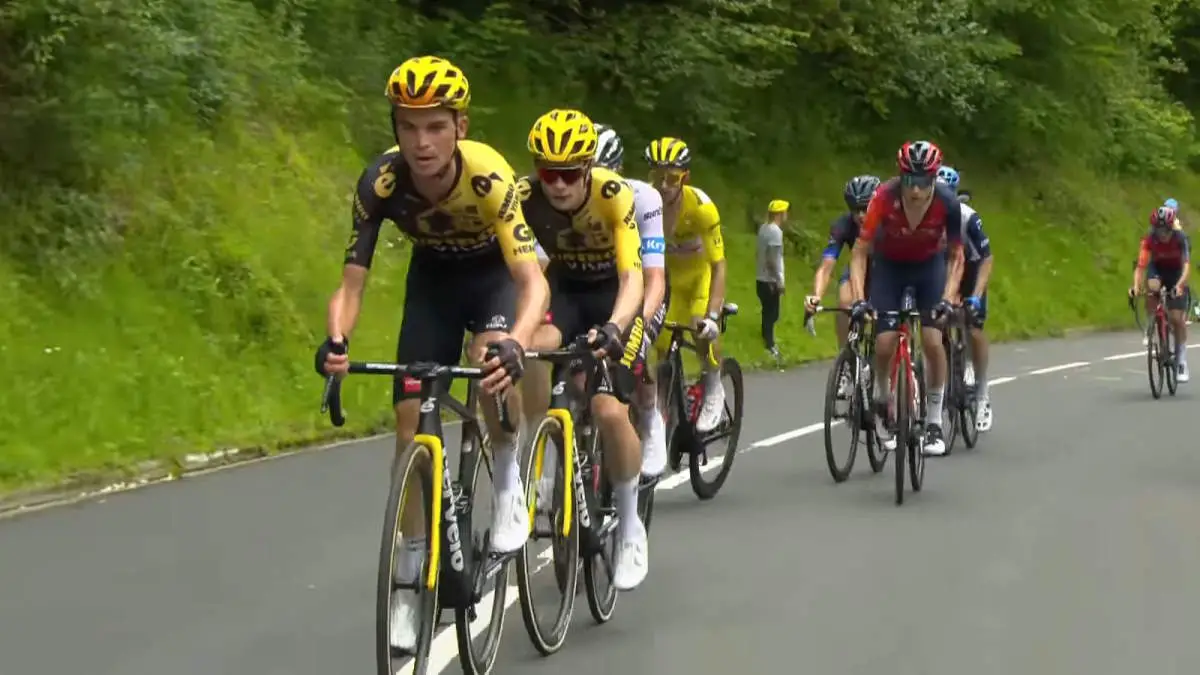A domestique is a rider in professional road cycling who works for the benefit of their team and leader, rather than trying to win the race. The term is derived from French and translates to “servant”. The roles of a domestique may include setting the pace to tire out rivals, providing slipstreams for team leaders to ride in, chasing breakaway riders, providing mechanical or physical assistance, and carrying supplies like water and food from the team car during the race.
The Critical Role of Domestiques in Overcoming Air Resistance in Cycling
In cycling, the majority of the work done by a cyclist when moving at speed on flat ground is overcoming air resistance. As the cyclist moves forward, they push against the air in front of them, creating resistance. This resistance increases roughly with the square of the speed, meaning that the faster a cyclist goes, the more energy they need to expend to overcome the air resistance.
This is where the role of domestiques (servants, or in order to be more kind, helpers) becomes vital in professional road cycling. By positioning themselves at the front of their team, domestiques face the brunt of the air resistance, effectively shielding the team leader and other key riders from much of this force. This allows the team leader to ‘draft’ or ride in the slipstream of the domestique, which significantly reduces the energy they need to expend to maintain the same speed.
Therefore, a domestique’s job is essentially to sacrifice their own chances of winning the race to help their team leader conserve energy for the most critical parts of the race. Without the tireless work of the domestiques, the team leader would have to expend a lot more energy against air resistance, which could seriously hinder their performance in the race. This selfless role, although often unnoticed by casual spectators, is a critical component of team strategy in professional road cycling.

Roles of Domestiques
Domestiques have a crucial role to play in positioning their team leader for success, especially before and during significant challenges such as steep climbs, narrow or windy roads, and more. Here’s a breakdown of how they might do this:
Before/During Important Climbs:
Climbs are one of the most challenging parts of any race. The domestique’s role before a climb is to set a hard pace to wear down other teams and to position the team leader at the front of the peloton (main group of riders) to avoid any potential crashes or bottlenecks.
As the climb begins, the domestique will continue to set a steady pace to shield the team leader from the wind and allow them to conserve energy. In particularly grueling climbs, a team might employ a super-domestique (a rider who could be a team leader in their own right) to maintain this role as the group thins out. The goal is to keep the team leader in the best possible position for as long as possible so that they can then break away and push for the summit when the moment is right.
They can also act as satellite riders.
Narrowing Roads:
On narrowing roads, positioning becomes vital. A domestique will work hard to keep the team leader near the front of the group where it’s safer, and where the leader has more control over their own destiny. Being near the front also means they can respond more quickly to attacks from rival teams.
Windy Conditions:
In windy conditions, a domestique may ride directly in front of the team leader to shield them from the headwinds, thus allowing the leader to save energy by riding in their slipstream. If the wind is coming from the side (crosswind), domestiques may ride slightly ahead and to the windward side of their leader, creating a protective ‘echelon’ formation.
All these strategies aim to preserve the team leader’s energy as much as possible for the critical moments in the race, whether that’s a punishing climb, a high-speed descent, or a sprint finish. The tireless work of the domestiques, often away from the limelight, forms the backbone of any successful cycling team.
Do domestiques win races for themselves?
Yes. Despite the seemingly subordinate role, being a domestique is crucial to team strategy and requires a high level of skill, endurance, and selflessness. In many cases, a successful team leader cannot win without the support of dedicated domestiques. They might not receive the same level of attention as the race winners, but their role is highly valued within the sport. Occasionally, domestiques may also have the opportunity to go for stage wins, particularly in large stage races like the Tour de France, or Giro d’Italia, if the team’s overall strategy allows it.
circumstances such as crashes, mechanical problems, or health issues can cause the team leader to lose significant time or to abandon the race entirely. When such situations occur, teams often reassess their strategy and may designate a particularly strong domestique to step into the leader’s role.
Since these domestiques are typically strong riders themselves, they may indeed be able to win stages, or even the overall race, given the right circumstances. This potential shift in roles underlines the importance of every member of a team in cycling, not just the designated leader. The sport requires not only physical strength and endurance but also adaptability and strategic planning in response to often unpredictable race developments.
For instance, during the 2020 Giro d’Italia, Team Ineos Grenadiers’ designated leader Geraint Thomas had to abandon the race due to a crash. Tao Geoghegan Hart, originally serving as a domestique, then took over the leadership role and ultimately won the Giro.
So while a domestique’s primary role is to support their team leader, they also must be ready to step into that leading role themselves if circumstances demand it. This makes them not only support riders but also potential race leaders.
What is a Super-domestique?
A “super-domestique” is a term used in professional cycling to describe a rider who, in any other team, would be a leader due to their superior skills and performance. However, within their current team, they work in a support role to the designated leader.
Super-domestiques are typically capable of winning stages or even entire races themselves, but their primary role is to support their team leader. They are often the last rider to assist the team leader in challenging parts of the race, such as steep mountain climbs or challenging individual time trials.
Their role is to pace the team leader, chase breakaways, and shield the leader from the wind to reduce air resistance (a strategy known as drafting). They also protect the leader from attacks by other teams and are generally there to handle any unexpected issues that may arise during the race.
The concept of the super-domestique highlights the team-oriented nature of professional cycling. Even though these riders have the capability to be leaders themselves, they sacrifice their individual ambitions for the good of the team. Their contributions are highly valued, and they play a crucial role in the team’s overall success.
The origin of the word “Domestique”
The term ‘domestique’ was initially used in the world of professional cycling as a form of derogation for Maurice Brocco (28 January 1883, in Fismes – 26 June 1965, in Mûrs-Erigné), a prominent French professional road bicycle racer who competed between 1906 and 1927. Its first known use occurred under intriguing circumstances during the 1911 Tour de France.
Brocco’s potential for winning the 1911 Tour was dashed when he lost significant time on the route to Chamonix. Recognizing that he was out of contention for the overall victory, Brocco leveraged his reputation and offered his services to other competitors. François Faber, another racer, was facing potential elimination due to slow times, and he struck a deal with Brocco. Brocco decided to pace Faber, guiding him toward the finish line and saving him from elimination.
This action provoked the ire of the Tour’s organizer and chief judge, Henri Desgrange, who viewed it as a breach of the rules. However, lacking concrete proof and fearful that Brocco would appeal to the Union Vélocipédique Française, the national cycling body, Desgrange refrained from disqualifying him. Instead, he voiced his disapproval in his newspaper, L’Auto, where he labeled Brocco as ‘unworthy’ and a ‘domestique’. In his newspaper, L’Auto, Desgrange wrote:
“He [Brocco] is unworthy. He is no more than a domestique.”
Brocco, unfazed, vowed to ‘settle accounts’ with Desgrange. The next day, he stunned everyone by winning the stage by a staggering 34 minutes. As he passed other riders, including the yellow jersey wearer Gustave Garrigou, he taunted Desgrange, challenging the notion of his unworthiness. He showed his true abilities, underscoring that his earlier poor performance with Faber was a strategic choice rather than a lack of capability.
Desgrange, acknowledging Brocco’s talent, suggested that the racer had been ‘selling the race’. He called for Brocco’s disqualification, stating, “He deserves his punishment.”
While the role of domestiques had been accepted in other races, Desgrange was steadfast in his belief that the Tour de France should be a competition of individual prowess. His disputes with race sponsors, primarily bicycle factories that had different views, were frequent. It wasn’t until 1930, when Desgrange restructured the Tour de France to involve national teams, that he inadvertently acknowledged the role of teamwork and, consequently, the importance of domestiques in professional cycling. This crucial evolution acknowledged the undeniable reality of cycling as a team sport, thereby forever changing its dynamic.
The lowest rank of domestiques: Watercarriers
“Stars and Watercarriers” is a renowned documentary film that follows the 1973 Giro d’Italia, one of the most prestigious annual cycling races. Directed by Jørgen Leth, the film provides a fascinating glimpse into professional cycling, focusing on both the ‘stars’, or leaders of the race and the ‘watercarriers’, the term used to refer to the lowest rank of domestiques.
The title metaphorically encapsulates the diverse roles within a professional cycling team. The ‘stars’ are the team leaders, the highly skilled cyclists who are the primary contenders for the race win. They are the ones who receive most of the attention and glory. The ‘watercarriers’, on the other hand, are the workhorses of the team, often underappreciated yet vital for their team’s success. Their role, akin to domestiques, is to support their team leader by doing the bulk of the work, including carrying water bottles, setting the pace, and shielding their leaders from the wind.
This film provides a close-up view of the grueling, often thankless role of the watercarriers and highlights the stark contrast between the glory pursued by the stars and the hard, supporting work done by the domestiques. It emphasizes that, while the stars may take the accolades, they rely heavily on the tireless work of the watercarriers, who make significant sacrifices for the team’s success. In essence, “Stars and Watercarriers” underscores the inherently team-oriented nature of professional cycling.

Related: Top 10 Best Cycling Movies
Sources
- Domestique on Wikipedia
- What is a Satellite Rider? [Explained] - July 24, 2024
- Tour de France Winner Groupsets [Year by Year, from 1937 to 2024] - July 21, 2024
- Top 18 fastest Paris-Roubaix editions - April 7, 2024
